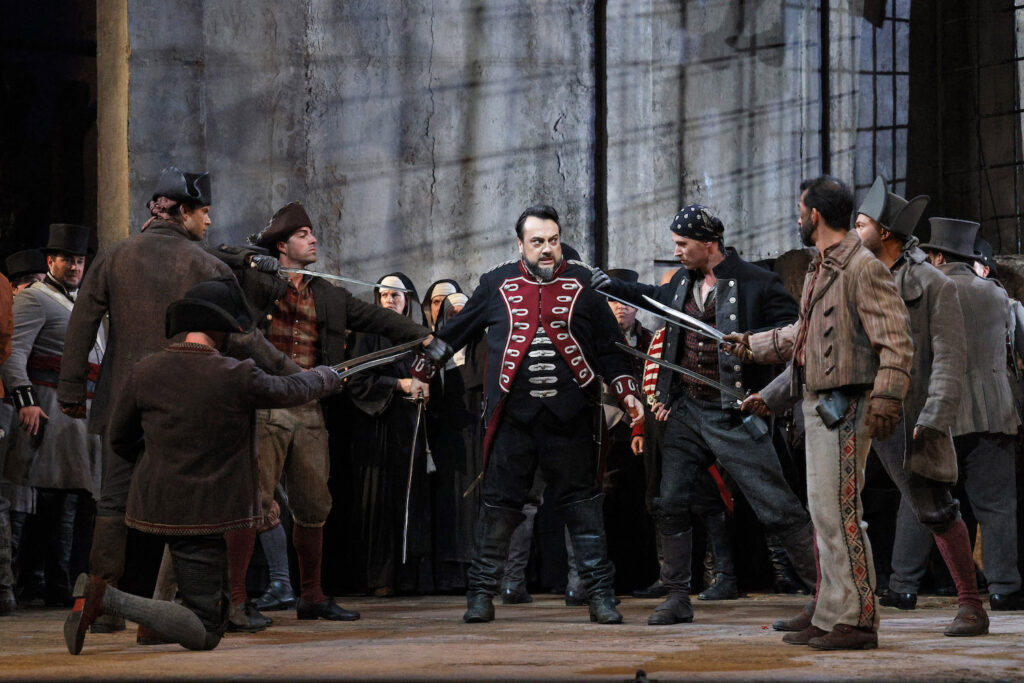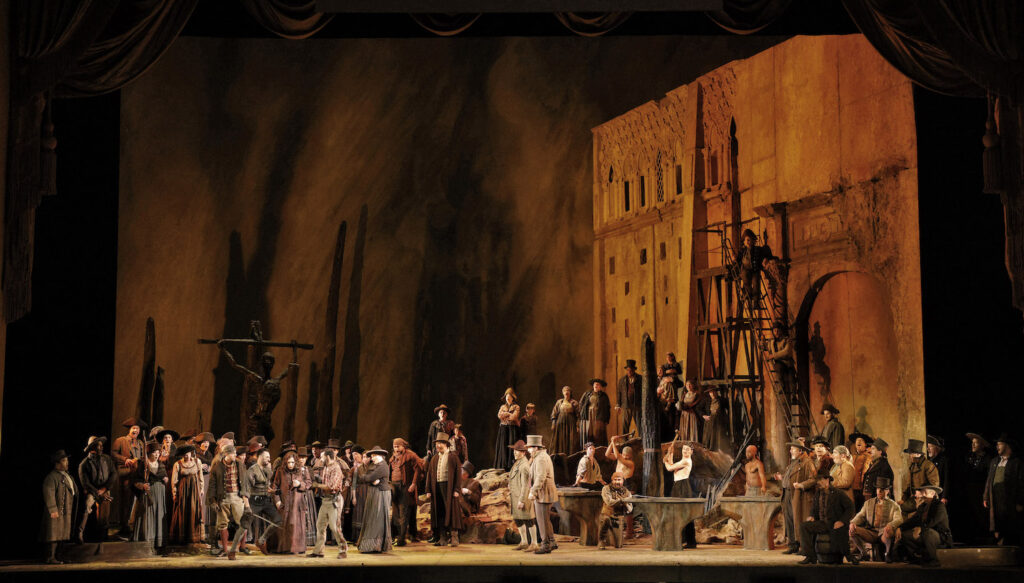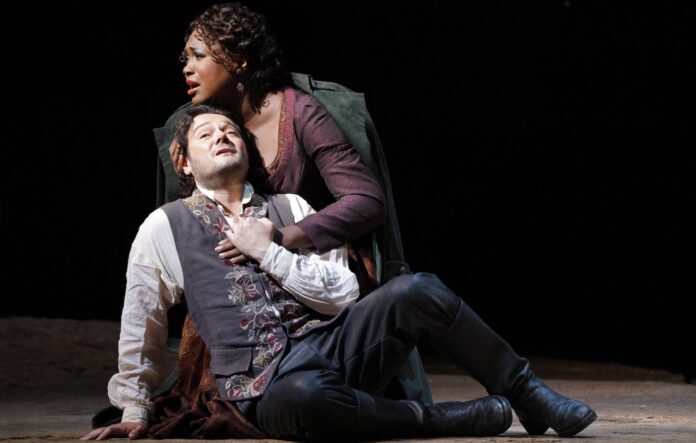When one compares operas, it’s interesting to see what’s revealed about a person when they state their favorites. Some prefer Kurt Weill buffas to Wagnerian epics. Some refuse to watch operas written after 1900. Still others live in fear of revealing how much they just don’t like La Bohème.
I pondered this as I watched the livestream of SF Opera’s new production of Verdi’s Il Trovatore (through October 1 at the War Memorial Opera House, SF). It’s similar to Puccini’s Tosca, written half-a-century later: both are about women who love artists, but the women are lusted after by obsessed men who abuse their state-given power in an attempt to steal the women away. Torture is optioned, deals are made, each woman offers herself to her villainous stalker to save her true love, the whole thing ends with an ordered execution. Though I personally prefer Tosca (its eponymous heroine has much more agency than Leonora here, who mainly just reacts to the goings-on), I certainly don’t hate Il Trovatore.
How can you hate the opera that gave us the “Anvil Chorus”?
The time is 15th Century Spain. Count di Luna (George Petean, Romania) is less concerned about his duties to the crown and more with his lust for Leonora (Angel Blue, US). Although marrying di Luna would be a smart societal choice for Leonora, she’s already begun a romance with Manrico (Arturo Chacón-Cruz, México), the titular trovatore (troubadour), whom she met while seeing him play in town. As is the case with toxic men, di Luna thinks Leonora’s “No” is just a “Yes” waiting to happen.

In the background of this, we learn that di Luna is the surviving son of his predecessor. He had a younger brother, but when their father saw a Roma woman standing near the child, the elder count claimed the woman put a curse on the baby and had her burned at the stake. With her dying words, she orders her daughter to enact vengeance on her behalf, which she does by kidnapping the supposedly cursed baby. Back in the present, the daughter has grown into the Roma mystic Azucena (Ekaterina Semenchuk, Russia) and the baby she stole was Manrico—the same Manrico now acting as rival to, unbeknownst to either of them, Count di Luna for the hand of Leonora.
Yeah, Il Trovatore has a well-earned reputation as being convoluted. What’s more, its depiction of Roma people is as controversial as that of Jews in The Merchant of Venice: both ethnicities are shown pretty sympathetically in their respective texts, but said texts lean heavy into gross stereotypes and have the primary ethnic character consumed by a vengeful bloodlust.
To SF Opera’s credit, they side-step the “g”-word and actually use the term “Roma” in the subtitles. As I don’t speak Italian, I don’t know if this was limited to the titles or if the lyrics were also adjusted, but it’s brief enough that it doesn’t seem too anachronistic and considerate enough to show that the Opera admins were aware of the word as a slur. (Still, it appears several times in the show’s program. Mainly, for historical context, but it’s still used rather casually.)

Oddly enough, Charles Edwards’ two-part rotating set seems to compliment on the opera’s infamous time-jumping narrative. This is the opera that has major actions begin—a duel, a jailbreak, etc.—only for the scene to immediately end, the next scene taking place a considerable time later, leaving the audience to glean the outcome. This works with the large wall of Edwards’ set because it almost seems like the moving wall represents several pages of a book that were skipped over; as if we, the audience, were reading a novel and skipped a few important chapters.
Help us save local journalism!
Every tax-deductible donation helps us grow to cover the issues that mean the most to our community. Become a 48 Hills Hero and support the only daily progressive news source in the Bay Area.
Granted, we should all be so lucky to have our readings scored by Verdi and conducted by Eun Sun Kim.
Angel Blue, renowned for her performances as Clara in Porgy & Bess, makes the most out of the paper-thin Leonora. Her handle on the tricky vibrato of “Mira, d’acerbe lagrime” reminds one that we wish her the best in this most convoluted of plans. Ekaterina Semenchuk has a similar handle on Azucena, though her performance occasionally devolves into scenery-chewing in a way that doesn’t really help the opera’s portrayal of Roma. Both George Petean and Arturo Chacón-Cruz do well in their respective roles of di Luna and Manrico, but the latter suddenly seems lost, acting-wise, in the show’s final scenes.

As this was a livestream I watched from home, there were no CO² readings to take with my Aranet4 (though the smoke-filled air outside didn’t help). Nevertheless, the pre-show and intermission footage showed barely a handful of live attendees masked.
The urge to look at Il Trovatore in terms of scale lies in the fact that it’s really an intimate love-triangle tale with several unnecessary elements added onto it, as if its creators (original playwright Antonio García Gutiérrez, Verdi librettists Salvadore Cammarano and Leone Emanuele Bardare, and Verdi himself) thought the central story couldn’t stand on its own. Yet, they stuff it so much that they have more happening off-stage than on.
Still, the bloated story remains entertaining as it rushes from two-and-a-half-hour yarn to a full sprint to the final curtain. SF Opera finds those entertaining moments, even if they don’t fully subvert the inherent racism of the revived text.
IL TROVATORE runs through October 1 at the War Memorial Opera House, SF. Tickets and further info here.





